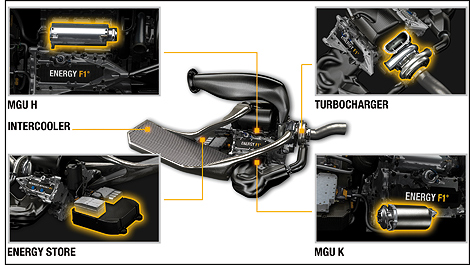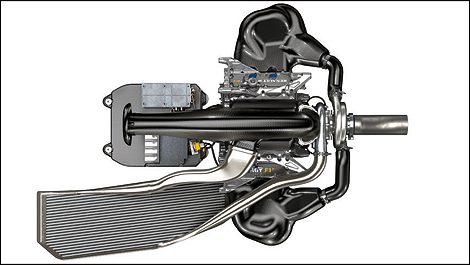Jan
1st
Stay connected Subscribe to our RSS feed
Renault Sport F1 explains here the various components of next year's V6 turbo power unit that will propel the Formula 1 cars starting next season.
Rob White, Deputy Managing Director at Renault Sport F1 explained that the next generation of F1 cars will be powered by a turbocharged 1.6-litre V6 internal combustion engine of around 600 bhp plus around 160 bhp of electrical propulsion from the energy recovery system, meaning the term ‘engine' will no longer fully describe a car's source of propulsive power. It is more relevant to refer to the complete system as a ‘Power Unit.'
TURBOCHARGER
A turbocharger uses an exhaust driven turbine to drive a compressor to increase the density of the intake air consumed by the engine and so make more power for a given displacement.
The residual heat energy contained in the exhaust gases after expansion in the cylinders of the engine is converted to mechanical shaft power by the exhaust turbine. The mechanical power from the turbine is used to drive the compressor, and also the MGU-H (see below).
As the turbocharger speed must vary to match the requirement of the engine, there may be a delay in torque response, often known as turbo-lag. One of the great challenges of the new Power Unit is to reduce this to near zero to match the instant torque delivery of the current V8 engines.
WASTEGATE
A wastegate is often used in association with a turbocharger to control the system. It is a control device that allows excess exhaust gas to by-pass the turbine, to match the power produced by the turbine to that needed by the compressor to supply the air required by the engine.
DIRECT FUEL INJECTION
With direct fuel injection (DI), fuel is sprayed directly into the combustion chamber rather than into the inlet tract upstream of the inlet valves. The fuel-air mixture is formed within the cylinder, so great precision is required in metering and directing the fuel from the injector nozzle. This is a key sub-system at the heart of the fuel efficiency and power delivery of the Power Unit.
MGU
A motor generator unit (MGU) is an electrical machine. When operating as a motor, the MGU converts electrical energy to mechanical energy. When it operates as a generator the MGU converts mechanical energy to electrical. The 2014 Power Unit uses two MGUs; an MGU-H (H for Heat - exhaust energy recovery) and MGU-K (K for Kinetic - kinetic energy recovery during braking).
MGU-K
The MGU-K is connected to the crankshaft of the internal combustion engine and is capable of recovering or providing power (limited to 120 kW or 160 bhp by the rules). Under braking, the MGU-K operates as a generator to slow the car (reducing the heat dissipated in the brakes) and so recovers some of the kinetic energy and converts it into electricity. Under acceleration, the MGU-K is powered (from the Energy Store and/or from the MGU-H) and acts as a motor to propel the car.
MGU-H
The MGU-H is connected to the turbocharger. Acting as a generator, it absorbs power from the turbine shaft to recover heat energy from the exhaust gases. The electrical energy can be either directed to the MGU-K or to the battery for storage for later use. The MGU-H is also used to control the speed of the turbocharger to match the air requirement of the engine (e.g. to slow it down in place of a wastegate or to accelerate it to compensate for turbo-lag.)
ERS
The Power Unit's ERS (Energy Recovery System) uses the MGU-H and MGU-K plus an Energy Store, plus some power and control electronics. Heat and Kinetic Energy recovered can be consumed immediately if required by the other MGU, or used to charge the Energy Store. The stored energy can be used to propel the car by the MGU-K or to accelerate the turbocharger by the MGU-H. Compared to 2013 KERS, the ERS of the 2014 Power Unit will have twice the power (120 kW vs 60 kW) and a performance effect 10 times greater.
Rob White, Deputy Managing Director at Renault Sport F1 explained that the next generation of F1 cars will be powered by a turbocharged 1.6-litre V6 internal combustion engine of around 600 bhp plus around 160 bhp of electrical propulsion from the energy recovery system, meaning the term ‘engine' will no longer fully describe a car's source of propulsive power. It is more relevant to refer to the complete system as a ‘Power Unit.'
 |
| Photo: Renault Sport F1 |
TURBOCHARGER
A turbocharger uses an exhaust driven turbine to drive a compressor to increase the density of the intake air consumed by the engine and so make more power for a given displacement.
The residual heat energy contained in the exhaust gases after expansion in the cylinders of the engine is converted to mechanical shaft power by the exhaust turbine. The mechanical power from the turbine is used to drive the compressor, and also the MGU-H (see below).
As the turbocharger speed must vary to match the requirement of the engine, there may be a delay in torque response, often known as turbo-lag. One of the great challenges of the new Power Unit is to reduce this to near zero to match the instant torque delivery of the current V8 engines.
WASTEGATE
A wastegate is often used in association with a turbocharger to control the system. It is a control device that allows excess exhaust gas to by-pass the turbine, to match the power produced by the turbine to that needed by the compressor to supply the air required by the engine.
DIRECT FUEL INJECTION
With direct fuel injection (DI), fuel is sprayed directly into the combustion chamber rather than into the inlet tract upstream of the inlet valves. The fuel-air mixture is formed within the cylinder, so great precision is required in metering and directing the fuel from the injector nozzle. This is a key sub-system at the heart of the fuel efficiency and power delivery of the Power Unit.
 |
| Top view of power unit. The front of the car is towards the left. (Photo: Renault Sport F1) |
MGU
A motor generator unit (MGU) is an electrical machine. When operating as a motor, the MGU converts electrical energy to mechanical energy. When it operates as a generator the MGU converts mechanical energy to electrical. The 2014 Power Unit uses two MGUs; an MGU-H (H for Heat - exhaust energy recovery) and MGU-K (K for Kinetic - kinetic energy recovery during braking).
MGU-K
The MGU-K is connected to the crankshaft of the internal combustion engine and is capable of recovering or providing power (limited to 120 kW or 160 bhp by the rules). Under braking, the MGU-K operates as a generator to slow the car (reducing the heat dissipated in the brakes) and so recovers some of the kinetic energy and converts it into electricity. Under acceleration, the MGU-K is powered (from the Energy Store and/or from the MGU-H) and acts as a motor to propel the car.
MGU-H
The MGU-H is connected to the turbocharger. Acting as a generator, it absorbs power from the turbine shaft to recover heat energy from the exhaust gases. The electrical energy can be either directed to the MGU-K or to the battery for storage for later use. The MGU-H is also used to control the speed of the turbocharger to match the air requirement of the engine (e.g. to slow it down in place of a wastegate or to accelerate it to compensate for turbo-lag.)
ERS
The Power Unit's ERS (Energy Recovery System) uses the MGU-H and MGU-K plus an Energy Store, plus some power and control electronics. Heat and Kinetic Energy recovered can be consumed immediately if required by the other MGU, or used to charge the Energy Store. The stored energy can be used to propel the car by the MGU-K or to accelerate the turbocharger by the MGU-H. Compared to 2013 KERS, the ERS of the 2014 Power Unit will have twice the power (120 kW vs 60 kW) and a performance effect 10 times greater.
 The latest auto news, reviews, prices, product and vehicle releases.
The latest auto news, reviews, prices, product and vehicle releases.